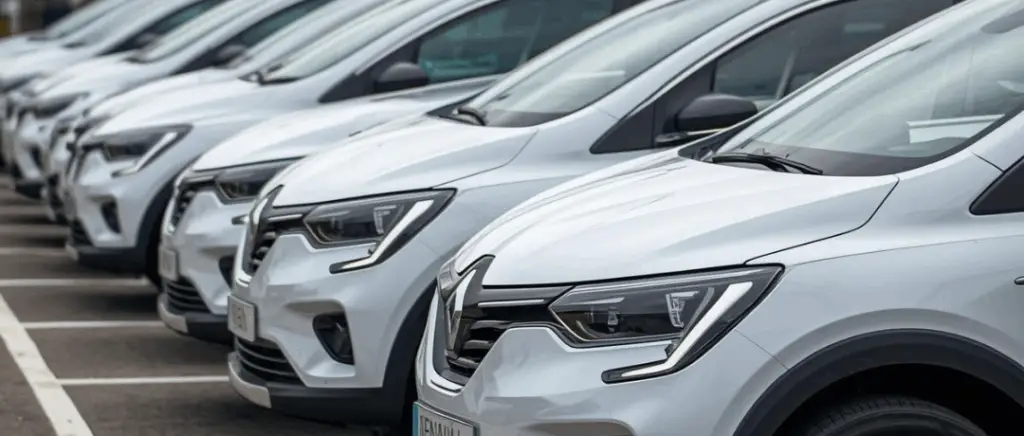What are the battery are essential when choosing professional electric vehicles?
The battery of an electric vehicle determines its autonomyIt's all about the technology, the performance, the lifespan and, to a large extent, the cost of ownership. Between technologies and functional characteristics, it can be difficult to find your way around. Here's what you need to remember:
Available technologies
Almost all current electric vehicles use lithium-ion batteries, a technology that has conquered the market thanks to its high energy density and reliability. There are several variants:
- Batteries LFP (Lithium Iron Phosphate) Safe, stable and durable, they are particularly well suited to everyday use and to drivers looking for 'value for money' technology.
- Batteries NCA (Nickel-Cobalt-Aluminium) With their high energy density, they offer a good compromise between extended range and shorter recharge times.
- Batteries NMC (Nickel-Manganese-Cobalt) Like NCA batteries, they combine long range with fast charging, making them particularly suitable for long journeys.
.
The characteristics of electric vehicle batteries
The different batteries used by carmakers also have key characteristics that are important to know before you decide on an electric car or plug-in hybrid.
- Power (in kW) This determines the battery's ability to deliver energy instantaneously. It has a direct influence on the vehicle's performance, particularly during acceleration and top speed.
- Capacity (in kWh) To put it simply, it can be compared to an energy reservoir. The higher the capacity, the more electricity the battery can store, and therefore potentially offer greater autonomy.
- Range (in km) This is the distance the vehicle can cover on a full charge. It depends on the battery capacity, but also on many external factors: driving style, weather, terrain, use of air conditioning or heating, etc.
- Voltage (V) Voltage: often overlooked, this indicator plays a key role in charging speed. The higher the voltage, the faster the energy can be transferred, reducing the duration of charging sessions.
Converting your fleet to electric: the complete guide
How does the actual range of electric vehicles vary according to the type of mission?
The range of an electric vehicle is not just a technical datum: it must above all be seen in relation to actual use of the driver. The right choice of battery optimises the cost of ownership, comfort of use and the lifespan of the equipment.
Short-distance commuting
For a driver who mainly drives in town or on short journeys (home-work, local trips), too much range is pointless.
A model offering about 300 km of autonomy more than covers everyday needs, while remaining affordable and energy-efficient.
Occasional journeys over longer distances
For your employees who regularly make slightly longer journeys (occasional business trips or long-distance journeys), a balance between autonomy and cost is essential.
A vehicle offering around 400 km range can limit the frequency of top-ups, while remaining affordable.
Intensive use for mobile professionals
Some profiles, such as travelling sales staff or technicians, travel long distances every day. In these cases, autonomy becomes a decisive criterion.
A model offering around 600 km of real range is recommended to avoid frequent recharging stops and ensure optimum productivity.
| Type of use | Recommended battery capacity (kWh) | Recommended range (km) | Examples of models |
|---|---|---|---|
| Urban commuting (short distance) | ~ 40 kWh | ≈ 300 km | Hyundai Kona 39 kWh, Peugeot e-208 (50 kWh) |
| Occasional longer journeys | ~ 60 kWh | ≈ 400 km | Kia EV6 58 kWh, Volkswagen ID.3 Pro (58 kWh) |
| Intensive professional use (long distances) | ≥ 90 kWh | ≈ 600 km | Tesla Model S (100 kWh), Mercedes EQS (108 kWh), BMW iX (111 kWh) |
How long can electric vehicle batteries last and what level of degradation can they be expected to suffer?
The question of battery life remains central for any buyer of an electric vehicle. It determines not only the longevity of the vehicle, but also its running costs and value.
A theoretical lifespan of between 8 and 10 years
On average, manufacturers estimate that an electric car battery can last 8 to 10 years. Some models, with their particularly high-performance chemistry or management system, can even reach 12 to 15 years before they become really limited for automotive use.
Most manufacturers also offer a 8-year or 160,000 km warrantyThis covers the loss of capacity below a certain threshold (often 70 %).
A gradual but measurable deterioration
It is accepted that a battery loses approximately 2 % of capacity per year. In other words, a 60 kWh battery would offer only 54 to 55 kWh of useful capacity after 5 years of normal use. This loss is gradual and rarely noticeable on a day-to-day basis in the first few years.
The role of size and load cycles
La battery size plays an important role:
A small battery has to be recharged more often, accumulating full cycles more quickly and wearing out more quickly.
A large batteryFor equivalent use, it undergoes fewer cycles and therefore has a longer service life.
On average, an electric vehicle battery is designed to withstand 1000 to 1500 full charge cycles. This corresponds to approximately 15,000 to 30,000 km per year depending on the driver's initial capacity and use.

How can we assess the reparability and maintenance costs of electric vehicle batteries?
What should you do if the battery in your electric vehicles breaks down or loses capacity? Understanding repairability and the associated costs is essential to anticipating and preserving the value of your business. fleet. Don't worry, there are often signs of this happening earlier. A battery that is starting to weaken can mean :
- a reduced autonomy,
- a loss of vehicle performance,
- a longer charging time.
A broken electric car battery: should it be repaired or replaced?
Any operation on a battery requires strict precautions:
always leave repairs to a professional!
Prevention and maintenance: preserving battery life
The lifespan of a battery depends to a large extent on its maintenance and use. To help you remember the right steps to take to preserve your batteries, you can use this mnemonic:
The 5 T's of battery ageing :
- Time → natural degradation (~2 %/year).
- Temperature → high heat (hot climates, rapid recharging) which accelerates wear.
- Extreme tension → use the battery close to 0 % or 100 % too often.
- Too much current → rapid recharging or intense electrical stress.
- Cycle tours → each complete cycle (discharge + recharge) gradually wears down the battery.
Good to know: a annual inspection by authorised professionals allows you to extend the life of the battery and anticipate any repairs that may be required.
What is the environmental impact of electric vehicle batteries and what recycling options should be favoured?
Limiting environmental impact
Electric vehicle batteries contain heavy metals and chemicals which, if not properly managed, can pollute soil and groundwater. Their manufacture also generates CO₂ emissions.
It is therefore essential to extend their life cycle and recycle them properly to reduce their ecological impact.
At European level, regulations require that, by 31 December 2025at least 75 % of lead batteries, 65 % of lithium batteries, 80 % of nickel-cadmium batteries and 50 % of other waste batteries be recycled. These rates will then have to be increased to 80 % for lead and 70 % for lithium no later than 31 December 2030.
How is an electric battery recycled?
Recycling follows several stages:
- Collection and sorting Used batteries are recovered from end-of-life vehicles, workshops or private individuals, then stored in secure conditions.
- Dismantling and separation The batteries are dismantled, and the various components (plastics, cables, cells, modules) are sorted to isolate the precious metals and recyclable materials.
- Precious metals recycling lithium, cobalt, copper or nickel are extracted and reintegrated into new manufacturing processes, reducing the need for new resources.
What technologies are used today?
There are two main methods for recovering metals:
- Pyrometallurgy The batteries are heated to very high temperatures to melt the metals and separate them.
- Hydrometallurgy a greener, low-temperature chemical method that recovers lithium more efficiently and produces less CO₂.
What second life for electric batteries?
Before final recycling, some batteries can benefit from a second life :
- Stationary energy storage Even with 70 to 80 % of their initial capacity, used batteries can store solar or wind energy for buildings or industrial sites (e.g. Renault uses Zoe batteries for this purpose).
- Partial re-use Some cells that are still in good condition are reconditioned for use in small electric vehicles or emergency equipment.
Giving batteries a second life means maximise their positive impact on the environment before final recycling.
How do you plan your fleet of electric vehicles to maximise battery performance and minimise costs?
Optimising a fleet of electric vehicles means planning usage to protect batteries and reduce costs. It's not just a question of managing journeys or maintenance, but of synchronising operational needs with good recharging and maintenance practices to extend battery life.
Plan your recharging to protect your batteries
Limit the load to approximately 80 % thanks tointelligent terminalsis one of the key strategies. By planning recharges according to daily journeys and stopping times, it is possible to reduce stress on batteriesto prevent premature wear and maintain optimum performance over the long term.
Organising journeys according to autonomy
When planning journeys, it is important to take account of thereal vehicle autonomy and daily needs. For short journeys, a partial recharge is sufficient, while longer journeys need to be programmed to limit frequent rapid charging, which accelerates battery degradation.
Preventive maintenance and battery monitoring
Regular monitoring of the batteries' state of health (SOH) and preventive maintenance can detect signs of wear before they become a problem. Scheduled inspections and compliance with manufacturers' recommendations help to maintain the performance of electric vehicles and reduce their total cost of ownership.
Regular monitoring of the batteries' state of health (SOH) and preventive maintenance can detect signs of wear before they become a problem. Scheduled inspections and compliance with manufacturers' recommendations help to maintain the performance of electric vehicles and reduce their total cost of ownership.
Support from A to Z
Thanks to our extensive network of partners, the Beev team can offer you the best commercial deals (purchase or leasing) and invaluable advice to help you make a success of your energy transition.
































